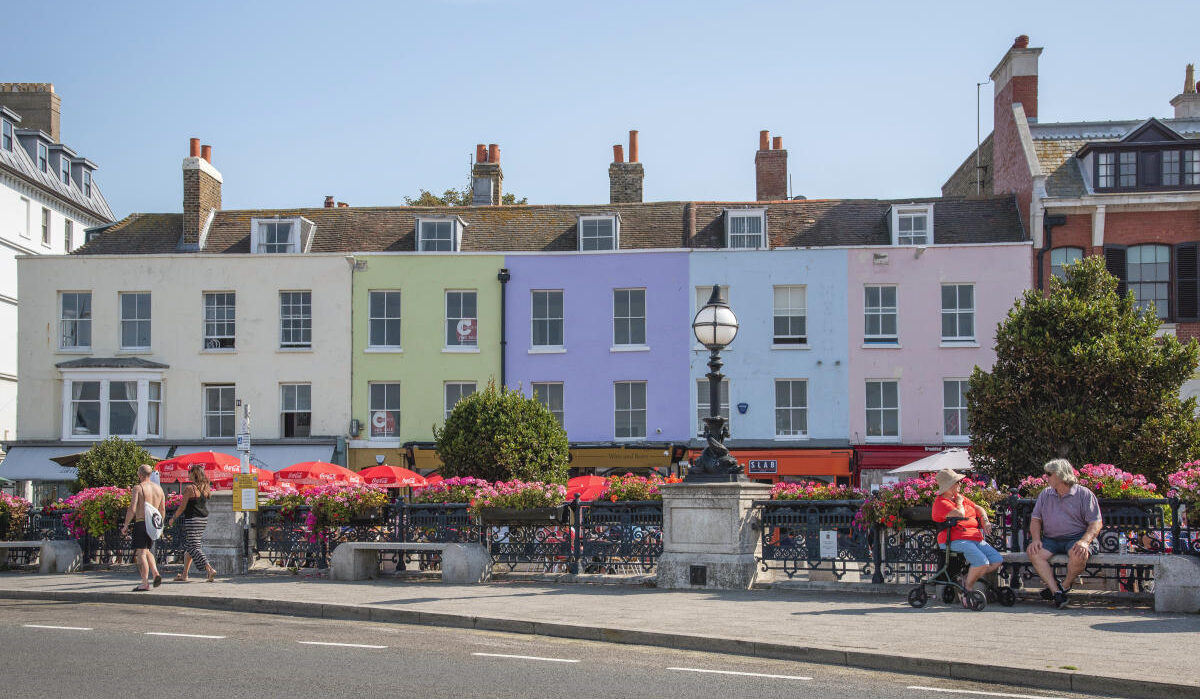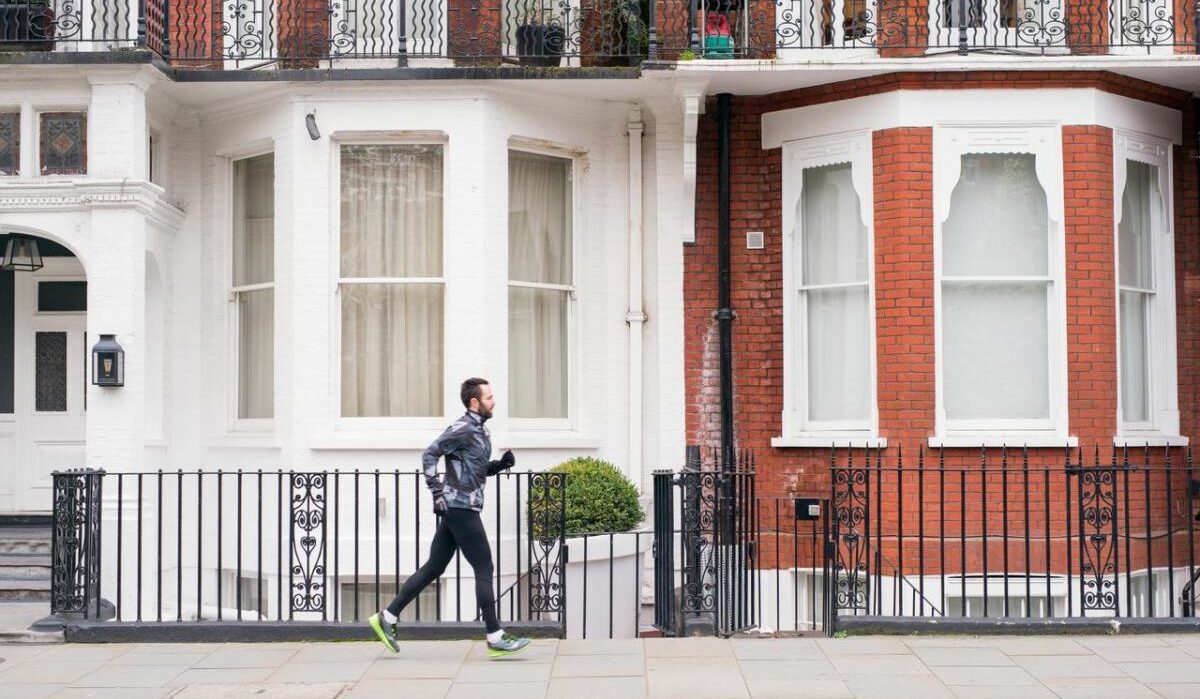Rise in over-40s taking out 35-year mortgages
The number of over-40s taking out 35-year mortgages has risen by nearly 40% this year. Higher house prices and the cost-of-living squeeze is thought to be driving the trend.
The number of people aged over 40 taking out mortgages with a term of 35 years or more has increased sharply.
More than 3,000 over 40s are predicted to take out the long-term mortgages by the end of this year, showing a 39% increase compared to last year, and a 433% increase compared to 2020..
In the first two months of this year, a total of 478 people in the over-40s age group took out a home loan with a term of at least 35 years, according to Financial Conduct Authority data acquired by Quilter.
Karen Noye, mortgage expert at Quilter, said: “Since the pandemic, we have seen a steady increase in the number of over 40s taking out mortgages with longer terms.
"And while this is not inherently wrong, it does have the potential to stretch people’s finances later in life.
“While the sales remain in the hundreds for now, the spike is concerning nonetheless.
"For those people considering entering into a mortgage that will see them well into retirement, it is vital they think ahead and are aware of the potential risks.”
Why is this happening?
There has been a steady increase in people taking out mortgages with terms of 35 years or more in recent years.
But the rise has previously been driven by younger people, particularly first-time buyers, who typically opt for a longer mortgage term to help keep their monthly mortgage repayments affordable.
The rise in older homeowners choosing a longer term is thought to have been driven by the combination of high house prices and the cost-of-living squeeze.
What are the pros and cons of a longer mortgage term?
The main advantage of a longer mortgage term is that it keeps monthly mortgage repayments lower.
For example, if you have a £250,000 with an interest rate of 5% and a 25-year mortgage term, your monthly repayments would be around £1,460.
If you increase the term to 35 years, your monthly repayments would fall to £1,260.
But there is a downside to repaying your mortgage over a longer period, as it means you will pay more in interest over the lifetime of the loan.
In the example above, you would pay a total of £188,443 in interest if you repaid your mortgage over 25 years, but the figure would soar to £279,922 if you repaid it over 35 years.
Why should older borrowers be cautious?
While many homeowners may be happy to pay more interest in the long run if it enables them to afford to buy the property they want, older borrowers should think carefully before taking out a 35-year mortgage term.
This is because the mortgage term will continue after they have retired. For example, if someone aged 41 who takes out a 35-year mortgage will be 76 by the time they repay it.
As a result, they need to make sure they can continue to afford their mortgage repayments once they have stopped working and that doing so will not negatively impact their standard of living.
People aged over 40 thinking of taking out a mortgage with a 35-year term should consider taking financial advice to ensure they can still afford it during retirement.
They could also opt to make overpayments before they retire, to help them payoff their mortgage sooner.
Key takeaways
- The number of people aged over 40 taking out mortgages with a term of 35 years or more has sharply increased
- The trend is being driven by high property values and increases to the cost of living
- The longer term means over-40s will not only pay more interest over the life of their loan, but will still be repaying off their mortgage during retirement
What has happened to the housing market since the mini budget?
How have home buyers reacted since the mini budget? And what should those who are moving - or considering a move - do now?
It’s been a frantic two weeks for the housing and mortgage markets.
Any active home mover or household looking to buy will have read the headlines around mortgage availability and pricing with a growing degree of consternation.
We have seen a drop in activity levels in the sales market, not precipitous, but a definite reaction from home buyers to increasing uncertainty and the disruption in the mortgage market.
The outlook for 2023 all depends on how quickly inflation is brought under control and financial markets getting more clarity on how the government will fund the recent tax cuts.
The longer mortgage rates stay at 6% or higher, the greater the impact on the housing market.
Sales market activity drops in wake of mini budget
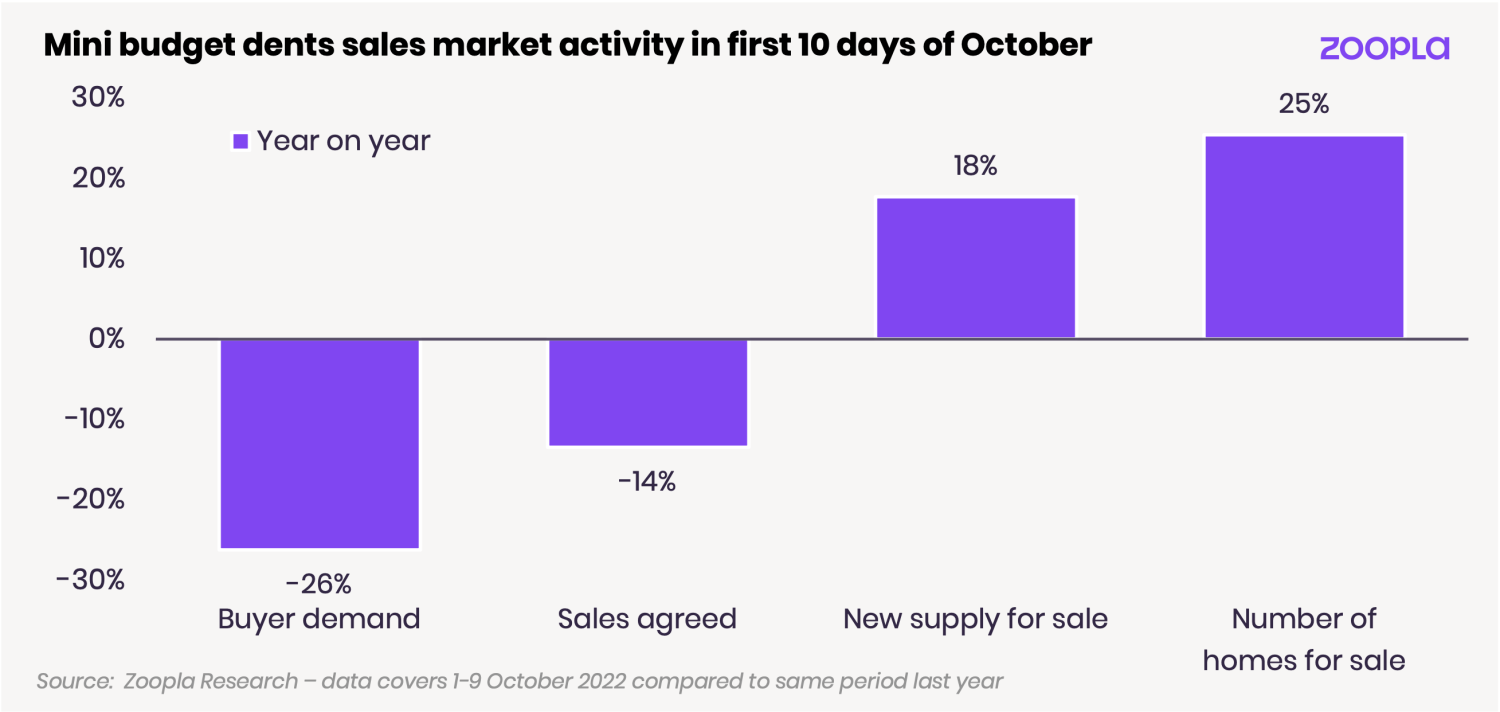
Mortgage rates were set to rise to 4-5% over 2022 before the mini budget.
This, together with increases in the the cost of living, were starting to weaken demand for homes over the summer months.
The fall-out from the mini budget has effectively added an extra 1% to mortgage rates, which are now settling around the 6% mark.
This increase represents a 25-30% hit to the buying power of home buyers using a mortgage.
Rising mortgage rates set to reduce buying power by 28%
Widespread reporting of mortgages being pulled and the increase costs of mortgage payments have certainly dented market activity.
Buyer demand starts to fall
Buyer demand - enquiries about homes for sale on Zoopla - have dropped by over a fifth in the last two weeks.
Homeowners are continuing to express an interest in buying homes but increased uncertainty is putting some people off.
Demand for homes is now at the weakest level since the pandemic started, although still above 2019 levels.
The reduction in demand has been broadly uniform across all regions and countries of the United Kingdom, with Scotland holding up the best.
The number of new sales agreed has also dropped by 15% over the last week.
Buyers who have not locked in cheap mortgage deals, or those who are worried over the outlook are stepping back from the market.
However, those with cheap mortgage rates locked in below 4% will continue to seek out homes to buy.
The risk is that a growing chorus of predictions of national price falls will see more people stop actively looking for homes for the rest of this year, reducing demand and new sales.
Asking prices were being adjusted down over the summer in the face of higher borrowing costs and weaker demand.
The last two weeks have seen a spike in asking price reductions on homes for sale.
This is a seasonal trend as we start the autumn selling market, but nearly 8% of homes for sale registered a reduction in the asking price of more than 5% in the last month.
Will house prices fall this year, given the hit to demand?
This is unlikely. However, there is a likelihood that surveyors will start to down-value in the face of greater uncertainty and reports of deals falling through.
Some sellers may accept price reductions in order to get sales through to completion, which may be passed along buying chains and risk the chain progressing.
Those would-be sellers who need a certain sale price to unlock their next move will likely step back from the market in the short term and reconsider their position in early 2023.
We will need to see large downward moves in asking prices across the market before national measures of completed house price sales start to record price falls.
Measures of asking prices or valuations may move sooner.
The reality is that the rest of 2022 will be about closing out the pipeline of sales and minimising fall-throughs, rather than seeing a lot of homes come to the market for sale.
We will get a much clearer picture of pricing for new business from January 2023.
Will homeowners start experiencing negative equity?
There is a huge equity cushion to absorb any price falls. Home prices have jumped over the pandemic, with the cost of houses in Wales increasing by 27% over the last two years.
A nationwide 15% reduction in house prices from today’s levels would result in very few cases of negative equity for mortgaged sales up to the end of 2021.
This highlights how the housing market has become increasingly equity driven and is much less dependent on high loan to value (LTV) borrowing over 90%.
Winter 2022 will see a pause in activity as buyers look to refinance
The final three months of the year is not traditionally a strong period for new buyer activity in the sales market, accounting for less than a fifth of new buyer demand over the typical year.
We still expect continued demand from a smaller group of buyers who are committed to proceed.
Recent data from the Bank of England showed a surprising 17% increase in mortgage approvals in August as buyers looked to lock in deals ahead of higher mortgage rates.
Sellers and buyers need to be flexible and realistic given the shifting economic backdrop.
Estate agents and mortgage brokers will help those in the middle of home purchases to complete sales, minimising the fallout from fall-throughs and collapsing chains.
It's not an easy task. But for committed movers with cheap mortgages, the desire to push ahead is likely to remain.
How can I keep my mortgage repayments down?
Banks are seeing strong demand from consumers on refinancing options in the face of £200-£500 monthly increases in mortgage repayments for a typical mortgage taken out 2 years ago.
The scale of this repayment shock can be reduced if borrowers and their lenders agree to extend the term of the mortgage a number of years.
This delivers a short term relief from higher repayments but at the cost of much bigger interest payments over the life of the loan.
That may not be an option for some with long mortgage terms, where extending may breach the age limits beyond which a mortgage can run. However, it will be one of many strategies banks and their customers consider and should keep arrears levels in check.
Keep watching the market and seeking advice
The outlook remains a balance of positives and negatives.
The importance of the home to households remains and pandemic and cost-of-living pressures will continue to stimulate home moves, probably from an older cohort of sellers.
Who will buy these homes and what they can afford will dictate the outturn for 2023. Some form of price correction is likely but the scale is far from clear and will vary by region and property type.
Buying a home is a long process lasting up to 9 or 12 months.
Existing homeowners wanting to move need to keep tracking their local market, the value of their home and considering the options for their next move.
It is a more challenging outlook for first-time buyers, who either live at home or rent before buying.
The cost of renting is rising fast, adding to affordability pressures, especially in southern England where prices are highest.
Many would-be buyers tend to focus on certain areas they know or have wanted to live in for years.
With higher mortgage rates hitting buying power, the key is looking more widely and considering other areas that might offer better value for money.
More working from home has opened up the options to look further afield.
Speaking to agents where you live today - and might want to move to tomorrow - early in the process is ever more important as households consider their next move.
Key takeaways
-
Demand for homes has fallen by a fifth since the mini budget
-
Homebuyers with cheap loans remain in the market and still want to complete on sales
-
The industry is focused on converting sales agreed into completions and minimising fall-throughs
-
To achieve a sale, sellers need to be realistic when pricing their homes
First-time buyers delay home purchase plans by two years
Those who do go ahead with a purchase are opting for longer mortgage terms due to the cost-of-living squeeze.
First-time buyers are delaying plans to purchase a home by nearly two years in the face of the cost-of-living squeeze.
Nearly three-quarters of people trying to get on to the property ladder say their goal has been impacted by rising prices, according to research by mortgage lender Aldermore.
A third of prospective first-time buyers have put their plans on hold, expecting an average delay of 20 months, while 19% are now looking to buy a cheaper home, and 64% have had to scale back the amount they save each month.
Those who do go ahead with a purchase are opting for longer mortgage terms to help make their monthly mortgage repayments more affordable.
A record 38% of first-time buyers and home movers opted for a mortgage term of 30 years or more in June, figures from trade body UK Finance showed.
Why is this happening?
Inflation, which measures the rate at which the cost of goods and services increases, is currently running at a 40-year high.
The situation impacts first-time buyers in two ways.
On the one hand, higher prices mean first-time buyers have less money to set aside towards a deposit after they have met their essential outgoings.
At the same time, the Bank of England is increasing interest rates in a bid to bring inflation back down to its 2% target.
Rising interest rates have fed through into higher mortgage rates, effecting the amount first-time buyers can borrow.
Moving from a 2% mortgage rate to a 5% one means the average first-time buyer will need an addition £21,250 a year in income for repayments to remain affordable.
What can first-time buyers do?
If first-time buyers are struggling to meet lenders’ affordability tests, they have three options.
They can buy a cheaper property, save a larger deposit - both of which will reduce the amount they need to borrow - or they can bring their monthly repayments down by opting for a longer mortgage term.
For example, if a first-time buyer purchases a property costing £269,000 with a 20% deposit, they will need a mortgage of £215,000.
If they opted for a typical two-year fixed rate deal with an interest rate of 5% and repaid their mortgage over the standard 25 years, they would have monthly repayments of £1,271.
But if they opted for a 30-year mortgage term, their repayments would fall to £1,165 per month.
Repaying their mortgage over 35 years would make monthly repayments even lower at £1,094.
But it is important to note that there is a downside to opting for a longer mortgage term, namely that you will pay more in interest over the life of your mortgage.
In the example above, you will pay a total of £162,060 in interest if you repay your mortgage over 25 years.
But the figure jumps to £200,500 if you repay it over 30 years, and £240,733 if you opt for a 35-year mortgage term.
What’s the background?
The rising cost of living and higher interest rates aren’t the only challenges would-be first-time buyers face.
Strong demand for property following the Covid-19 pandemic has sent property values soaring, with house prices rising by 8.3% during the past 12 months, according to our latest House Price Index.
Price increases have been even stronger for first-time buyer properties, with the average person now paying £269,000 for their first home, £33,000 more than a year ago.
But growth is expected slow going forward in the face of higher mortgage rates and rising living costs, as well as growing economic uncertainty.
Key takeaways
- First-time buyers are delaying plans to purchase a home by nearly two years in the face of the cost-of-living squeeze
- Nearly three-quarters of people trying to get on to the property ladder say their goal has been impacted by rising prices
- A record 38% of first-time buyers and home movers opted for a mortgage term of 30 years or more in June
Land Transaction Tax cut for buyers in Wales
Thresholds for Land Transaction Tax have been changed to reflect house price growth in Wales.
The level at which Land Transaction Tax in Wales kicks in has been increased to £225,000 to reflect strong house price growth in the last few years.
If you're buying a home costing up to £225,000, you won't have to pay any Land Transaction Tax. The change will save you up to £1,575.
But if you're buying a home in Wales costing more than £345,000, you'll see an increase of up to £550 in the tax.
This is because the rate charged on the portion of a property costing between £225,000 and £400,000 is being increased from 5% to 6%.
The changes come into force from 10 October 2022.
Rebecca Evans, Minister for Finance and Local Government, said: “This is a change tailored to the unique needs of the housing market in Wales and contributes to our wider vision of a fairer tax system. These changes will get support to people who need it and help with the impact of rising interest rates.”
Why is this happening?
The Welsh Government was considering making changes to the tax at its Budget in 2021 to reflect increases to property values.
House prices in Wales have soared by 27% in the past two years, according to our latest House Price Index. The region has benefitted from people reassessing their housing needs following the Covid-19 pandemic.
The Welsh Government decided to bring the changes forward after Chancellor Kwasi Kwarteng announced an increase in stamp duty in England and Northern Ireland in September.
What are the new Land Transaction Tax rates?
| Property price | Land Transaction Tax rate |
|---|---|
| Up to £225,000 | 0% |
| £225,001 to £400,000 | 6% |
| £400,001 to £750,000 | 7.5% |
| £750,001 to £1.5 million | 10% |
| Over £1.5 million | 12% |
GOV.UK
The tax is charged in slabs, which means buyers pay a different rate on different portions of their property’s value.
So if you buy a home costing £225,000, you will not pay any tax. If you buy one for £400,000 you'll pay £10,500, and if you're buying a £750,000 property you'll pay £36,750.
Who does it affect?
The change is great news for first-time buyers and people trading up the lower rungs of the housing ladder.
The Welsh government estimates 61% of homebuyers will not pay any tax at all on their purchase after 10 October as a result of the changes.
Even those buying more expensive homes higher up the ladder will not be hit too hard, with people purchasing a home worth more than £345,000 paying a maximum of £550 more in Land Transaction Tax.
But one group that will lose out is investment landlords and people purchasing holiday homes, as the reductions do not apply to those buying an additional property in Wales.
What’s the background?
As with the change to the stamp duty in England and Northern Ireland, the move aims to support the housing market at a time when activity is starting to slow down.
That said, the savings will be relatively small, with some purchasing a home for up to £345,000 saving only £1,575.
With interest rates expected to increase rapidly as a result of steep falls in the value of the pound, and mortgage rates already rising, this saving may not be enough to tempt buyers to go ahead with a purchase.
Key takeaways
- The level at which Land Transaction Tax in Wales kicks in has been increased to £225,000
- If you're buying a home worth up to £225,000, you'll no longer pay any tax - saving up to £1,575
- There's a small increase in the rate of Land Transaction Tax for homes that cost more than £345,000
- The changes will come into force from 10 October 2022
Pandemic house price boost adds to affordability troubles
The pandemic-led property boom leads to affordability problems, as some parts of the UK experience 10 years' price growth in the space of just two years.
The effect of the pandemic on home moves and consequent house price rises has meant the average house price has increased five times more than the average price of flats since 2020.
In the last two years, the search for space and record low mortgage rates led to a surge in demand for new homes - and that demand pushed up house prices as buyers competed to secure their dream properties.
Some parts of the country have seen 10-years’ worth of price growth in just two years, such as Wales, which recorded a 27% increase in house prices.
Similarly, the North East and Scotland, which had experienced below average growth since 2009, has seen four-to-five years’ growth in the space of just two years.
In the South, the capital lagged behind the rest of the country in terms of house price growth.
Yet despite this, the average home in London has risen by £100,000 in value since the pandemic began.
Are we shifting to a buyers' market as more homes are reduced in price?
Conversely, the average flat in the capital has risen by just 2.4%, the weakest growth across the country, as buyers prioritised their needs for more space and a place to work from home.
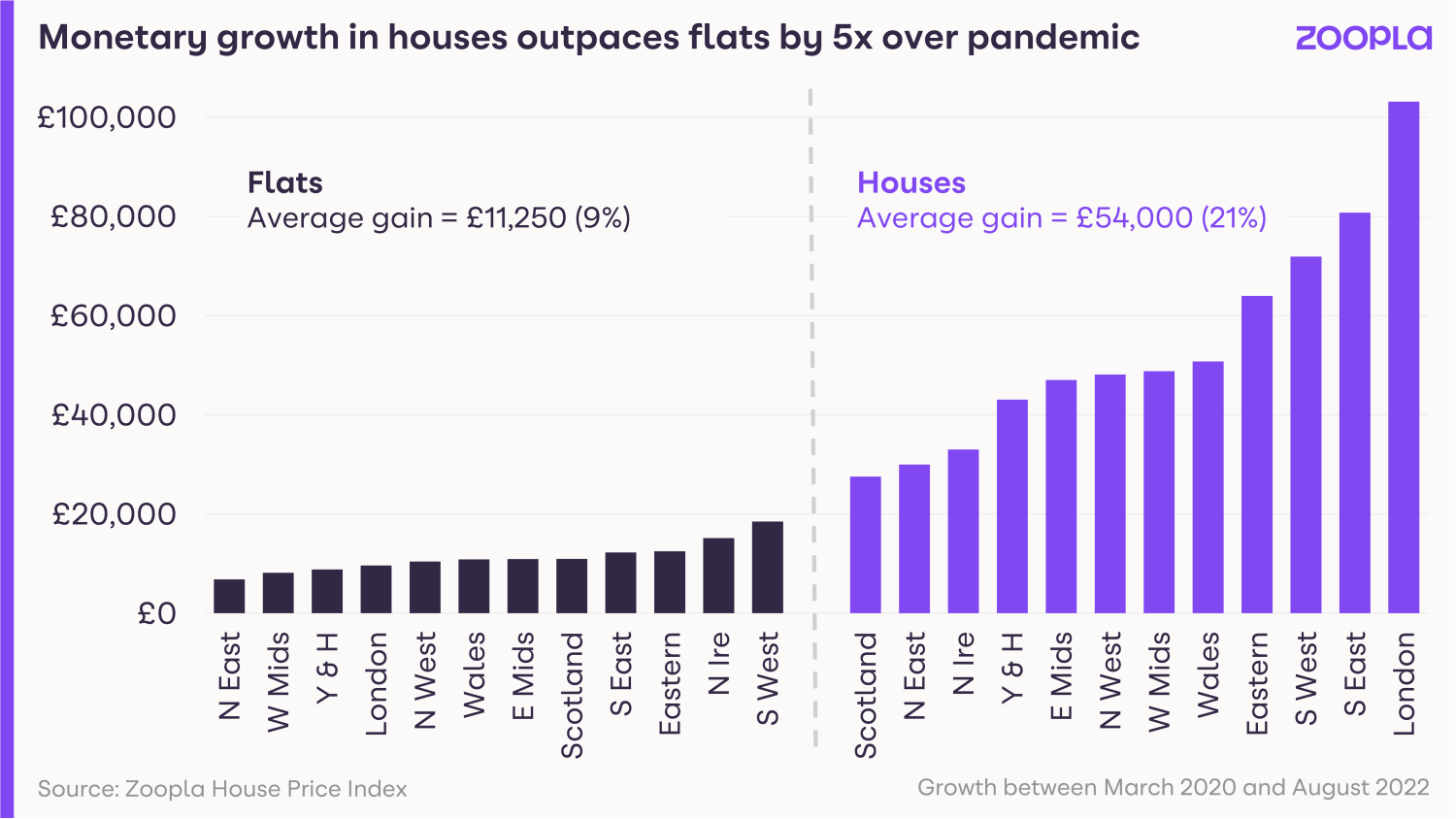
These sizeable increases in house prices over the pandemic are set to be compounded by the impact of higher mortgage rates on market activity as we move towards the end of 2022 and into 2023.
Key takeaways
- The average house price has risen five times faster than the average flat since the pandemic
- Some parts of the country have seen 10 years' price growth in just two years
- The average home in London has risen by £100,000 since the pandemic began
Rising mortgage rates set to reduce buying power by 28%
With mortgage rates set to hit 5% by the end of this year, which areas are going to be hit hardest and what can buyers do to combat rising rates?
The macro backdrop for the housing market has evolved rapidly over the summer
Central banks have increased interest rates to bring down inflation.
Rising energy prices are adding to the cost-of-living squeeze and UK consumer confidence has hit an all-time low.
The UK government has responded with tax cuts and an energy price cap to support housing demand.
But while changes to stamp duty will boost some segments, the recent spike in borrowing costs are set to push mortgage rates higher.
Most new loans are on fixed rates and the costs to secure financing for these mortgages does not directly follow base rates.
That said, costs for new mortgages have surged recently, and mortgage rates are on track to reach 5% by the end of this year and even higher.
That’s more than double the rates at the start of 2022.
Our research shows that higher mortgage rates will reduce buying power by as much as 28% as rates rise from 2% to 5%.
That’s if buyers want to keep their monthly mortgage payments the same.
And the impact of this is likely to last into 2023.
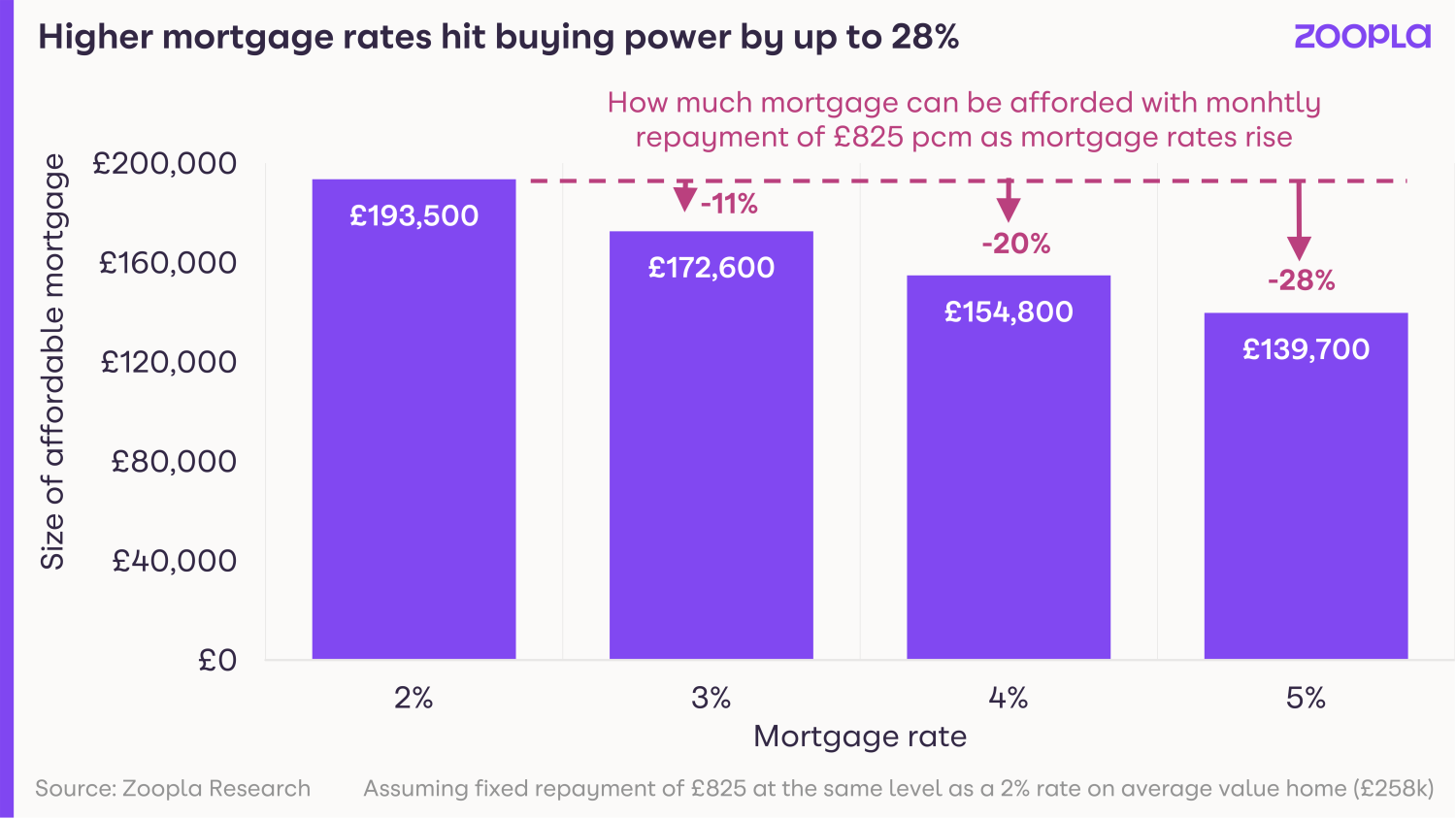
Buyers now have four options to help combat rising mortgage rates
1: Put down larger deposits
2: Allocate more income to mortgage costs
3: Adjust their budgets by looking into smaller properties or cheaper areas
4: Wait on the sidelines until the outlook for borrowing costs becomes clearer.
Are we shifting to a buyers' market as more homes are reduced in price?
Mortgage approvals up 17% in August
Mortgage approvals for house purchases increased by 17% M/M, seasonally adjusted, to 74,300 in August, according to the Bank of England, showing the resilience of demand.
This is the highest level since January this year, where mortgage approvals hit 74,500, and above the 12-month pre-pandemic average up to February 2020 of 66,800.
The rise follows a downward trend over the previous several months, but suggests buyers and homeowners were getting ahead, ensuring they secured finance before rates rose.
On a non-seasonally adjusted basis, the Y/Y increase was 0.9%.
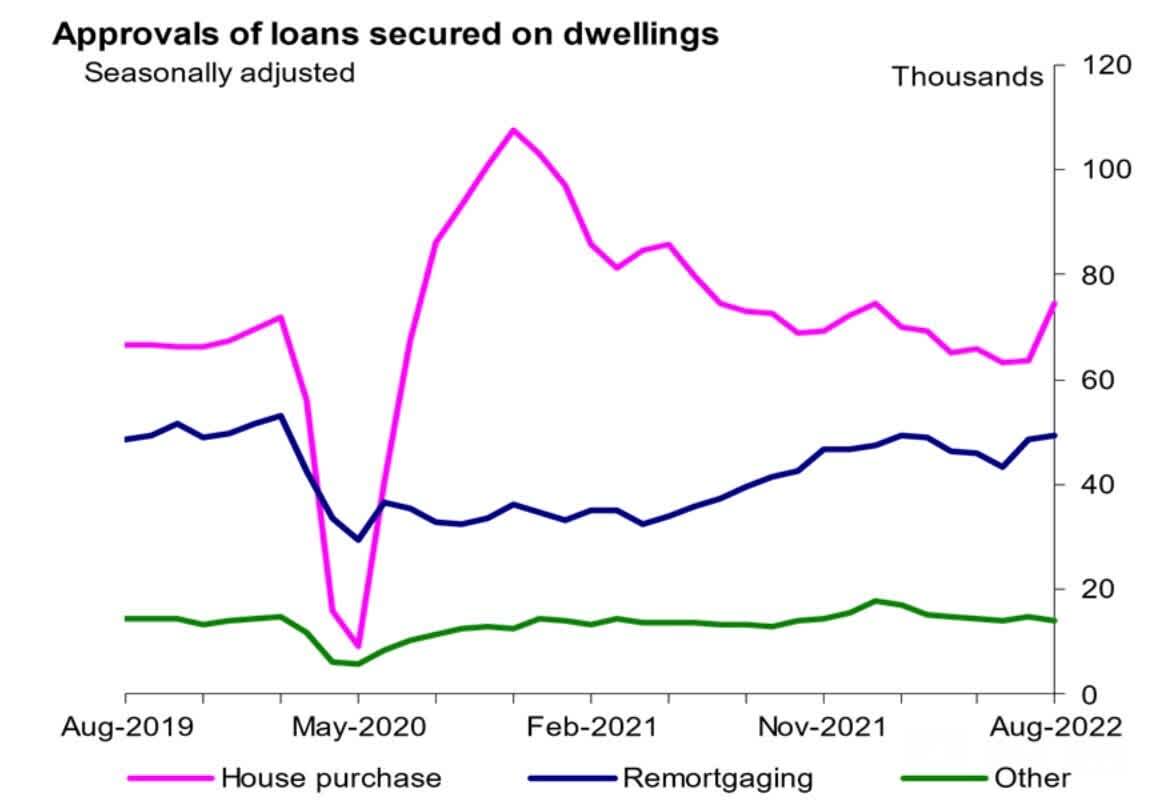
Areas with expensive homes and highest growth hit hardest
Rising mortgage rates are set to have the biggest impact on areas where homes are already at the higher end of the market, or where house prices have surged over the pandemic.
Pandemic house price boost adds to affordability troubles
The average UK home has risen by 8.2% - or £19,650 - in the last 12 months and although the quarterly growth rate is slowing, there are no immediate signs of a major slowdown in price inflation.
Looking ahead, higher mortgage rates will have the greatest impact on activity in these higher value markets and areas which have registered the greatest surge in prices over the the last two years.
Key takeaways
- Mortgage costs have surged recently, and mortgage rates are on track to reach 5% by the end of this year
- Buyers now have four options to combat rising mortgage rates:
- put down larger deposits
- allocate more income to mortgage costs
- adjust budgets by looking into smaller homes or cheaper areas
- wait until the outlook for borrowing costs becomes clearer
- Areas with more expensive homes are set to be hit hardest by the rising rates
Are we shifting to a buyers’ market as more homes are reduced in price?
After two years of being a red-hot sellers’ market, it looks like the UK housing market is shifting back to becoming a buyers’ market.
Over the spring and summer this year, an increasing number of homes for sale underwent price reductions.
And there has been a clear upward trend in the proportion of listings which have had asking prices reduced by 5% or more.
Pandemic house price boost adds to affordability troubles
Our latest data shows 6.1% of homes for sale have been reduced in price this year, the highest level since before the pandemic, although re-pricing is a common seasonal trend as we enter the autumn market.
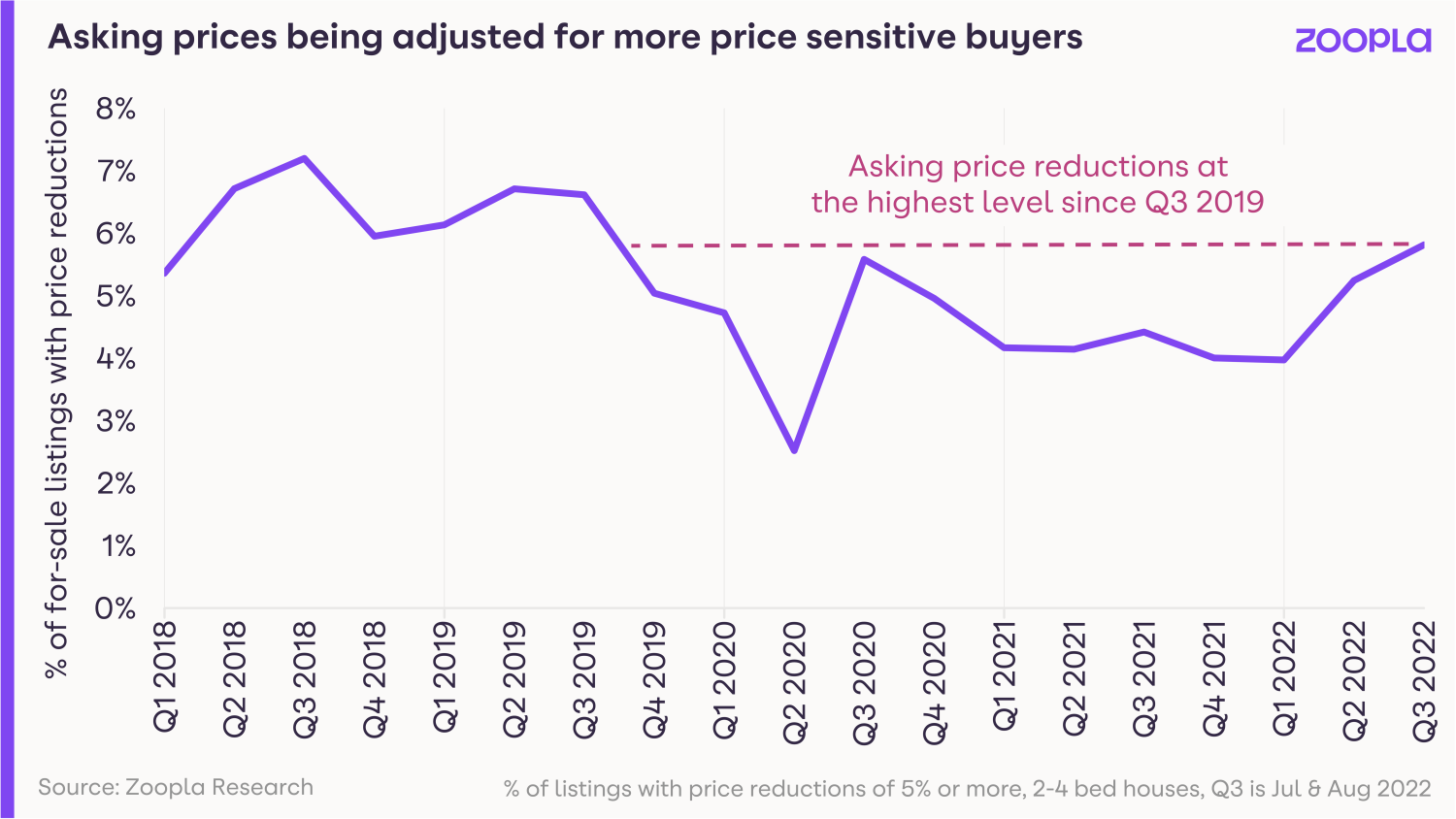
After two years of being a red-hot sellers’ market, it looks like the UK housing market is shifting back to becoming a buyers’ market.
Rising mortgage rates set to reduce buying power by 28%
However, these price adjustments are to be expected as the market transitions from one where demand greatly exceeded supply to one where buyer demand is reducing.
The reductions don't mean we're about to see big price falls, but they do suggest house price growth will start to slow at the end of this year and into next.
That means anyone looking to sell their home this autumn and winter - or next year - will need to make sure their house is priced at the right level to ensure a sale.
And while demand for homes will weaken, we still expect ongoing pandemic and cost-of-living pressures to stimulate homeowners to want to move, while being more cautious on pricing.
Key takeaways
- Over the spring and summer this year, an increasing number of homes for sale underwent price reductions
- However, this is to be expected as the market transitions from one where demand greatly exceeded supply to one where buyer demand is reducing
- The reductions don't mean we're about to see big price falls, but they do suggest house price growth will start to slow at the end of this year and into next
Record number of mortgages pulled by lenders
More than 900 deals were withdrawn in one day as lenders looked to reprice their loans. But the move is set to be temporary as lenders reassess their rates.
Mortgage lenders have withdrawn deals at a record rate in response to the current market volatility.
More than 900 products – representing one third of the mortgage market – were pulled overnight between 27 and 28 September, the highest level since financial information group Moneyfacts started keeping records.
More than a dozen lenders either withdrew or repriced their mortgages, including big names such as Halifax, Santander and Nationwide Building Society.
Their actions left 2,661 different products available, less than half the 5,315 deals that were on offer in December last year, before the Bank of England started to increase interest rates.
But homeowners were reassured that the situation is likely to be temporary, while lenders reassess the interest rates they charge in response to the current market volatility.
Rachel Springall, finance expert at Moneyfacts, said: “Borrowers would be wise to keep calm over the current volatility in the mortgage market and seek the advice from an independent broker.
“Various lenders have been very vocal that their decision to withdraw products is a temporary measure, amid the uncertainty over interest rates."
Why is this happening?
Chancellor Kwasi Kwarteng mini-Budget triggered a steep fall in the value of the pound, with investors worried his plans to cut taxes would boost inflation.
The Bank of England has already increased interest rates from 0.1% to 2.25% in a bid to bring inflation down from its current 40-year high.
But economists have warned that it may now have to hike the cost of borrowing even higher than previously thought, with some predicting they could peak at 5% next year, while money markets have priced in a rise to 6% by May 2023.
Speculation that interest rates will have to rise faster and further than previously thought has led to lenders’ own borrowing costs increasing from 3.6% in early September to 5% now.
This rise means lenders can no longer afford to offer mortgages at their previous rates, so they have withdrawn their products while they reprice them.
What does it mean for homeowners?
The good news for homeowners is that lenders are expected to relaunch their ranges once they have repriced them.
It is worth noting that, unlike at the start of the Covid-19 pandemic when lenders withdrew products for people with small deposits, mortgages have been pulled across nearly all areas of the market, with people looking to borrow 75% of their home’s value seeing the biggest fall in choice.
This suggests that the lenders do simply want to reassess the rates they charge and not that they have lost their appetite to lend to certain types of borrower.
The bad news is that when they do relaunch their ranges, interest rates will definitely be higher.
The average cost of a two-year fixed rate mortgage has already increased from 4.24% at the beginning of September to 4.81% now, while interest rate charged on a typical five-year fixed rate deal has risen from 4.33% to 4.76% during the same period.
Economists are predicting the Bank of England will make a significant increase to interest rates when it next meets in early November, possibly raising the Bank Rate by as much as 1% in one go.
As a result, mortgage rates are likely to get significantly more expensive in the months ahead.
What should I do?
If you are on your lender’s standard variable rate – the rate you revert to when your mortgage deal comes to an end – you should remortgage as soon as possible.
Although mortgage rates have risen, at 4.81%, the average two-year fixed rate loan is still cheaper than the average standard variable rate at 5.4%. As a result, switching would save someone with a £200,000 mortgage around £70 a month.
If you have six months or less left on your current mortgage deal, you should also move quickly to secure your next one.
Lenders will let people ‘book’ a new rate between three to six months before their current one ends.
The situation is harder to call if you have more than six months left on a fixed rate or tracker product, as you may incur penalties if you exit the mortgage early.
Even so, in some cases, it may be worth doing this to enable you to secure a new deal before mortgage rates rise further.
As each case will be different, you may want to consider consulting a mortgage broker to help you decide what the best course of action is for you.
It is worth noting that five-year fixed rate deals are now cheaper than two-year ones – reversing the normal situation in which homeowners have to pay a premium for the security of having their rate fixed for a longer period of time.
This suggests that while markets anticipate steep rises in interest rates in the short-term, they expect rates to be back on their way down again after a couple of years.
Key takeaways
- More than 900 products, representing one third of the mortgage market, were pulled overnight between 27 and 28 September
- The situation is likely to be temporary while lenders reassess the rates they charge following predictions interest rates could hit 6%
- The average cost of a two-year fixed rate mortgage has risen from 4.24% at the beginning of September to 4.81% now
What the weak pound means for the mortgage market
The value of the pound has tumbled following Chancellor Kwasi Kwarteng’s mini-Budget. We take a look at what it’s likely to mean for mortgage rates.
The value of the pound has fallen steeply since Chancellor Kwasi Kwarteng delivered his mini-Budget.
The pound briefly hit a record low against the US dollar on Monday, as markets digested the implications of tax cuts and higher government borrowing for the UK economy.
Many economists have predicted the giveaways will stoke inflation and lead to higher interest rates.
We take a look at why the pound has dived and what this means for homeowners.
Why has the pound fallen so much?
The pound has been weakening for some time against the dollar in line with other global currencies as the US central bank, the Federal Reserve, increases interest rates in the USA, drawing in international investors.
The pound has weakened further due to market uncertainty over the funding costs for the spending changes announced in the mini budget.
Kwarteng announced tax cuts and other support measures worth an estimated £45 billion in his mini-Budget.
He believes putting more money in people’s pockets and reducing the amount of tax businesses have to pay will increase demand and help to drive economic growth.
In fact, he has set a target for GDP to reach 2.5% a year over the medium term, arguing that growing the UK economy will reduce the UK’s debt-to-GDP ratio in a fiscally sustainable way.
Unfortunately, the markets don’t agree.
Investors are worried that the Chancellor’s giveaways will lead to higher inflation, which will mean higher interest rates that will reduce economic growth.
The Bank of England has already had to raise interest rates aggressively in a bid to tackle inflation, which is currently at a 40-year high.
It has increased the Bank Rate from 0.1% in December to 2.25% now.
Investors are concerned that the Bank of England will now have to raise rates even higher than previously thought to get inflation back under control.
At the same time, they think the tax cuts will lead to higher government borrowing.
This has made them lose confidence in the pound, leading to them selling the currency, causing its value to drop.
What does the fall in the pound mean?
The value of currencies fluctuates all the time. But the recent drop in the pound is of a different order of magnitude, with the currency at one point losing nearly 5% of its value against the US dollar.
This is important because global commodities – everything from oil to grain – are priced in US dollars.
As a result, the drop in the pound means the cost of everything the UK imports has become more expensive, which will drive inflation higher.
In order to control inflation, the Bank of England may have to hike interest rates even more aggressively than previously thought.
How high could interest rates go?
Before the mini-Budget, economists were predicting interest rates would peak at between 3% and 4% in the middle of next year.
The money markets now expect them to reach 6% by May. If this happened, it would represent a 3.75% increase from the current level of 2.25%.
But it is important to stress that this is just a prediction - markets can be volatile and fluctuate in times of greater uncertainty..
Markets are less confident in the UK government’s plans, especially given the fact that the proposals were not accompanied by an independent forecast from the Office for Budget Responsibility.
Hopefully If the government can regain their confidence, the pound should strengthen again, and interest rates may not have to rise so steeply.
What happens next?
There is speculation that the Bank of England will have to step in to help restore confidence in the pound, either by holding an emergency meeting to increase interest rates, or raising them steeply at its scheduled meeting in early November.
Unfortunately, the increase would need to be dramatic to make a difference, with traders betting rates could be increased to just below 4% by November.
What does this mean for mortgages?
Mortgage rates reached record lows in early 2022 but higher inflation and rising interest rates means higher borrowing costs for new buyers using a mortgage and those looking to refinance.
Since December last year, average mortgage rates have risen across the board as the cost of money for banks has risen.
If interest rates do rise to 6% by May, and mortgage rates increase by the same amount, it would add £465 a month to a £200,000 mortgage.
That is a pretty sizable increase for new borrowers.
Existing borrowers will have had to prove to their bank they could afford a 6 or 7% mortgage rate to get a mortgage in the last 5 years, so there is some insulation to higher rates but perhaps less so at a time of rising living costs.
There are steps homeowners can take to protect themselves.
What should I do?
If you are currently on a fixed rate mortgage, you don’t need to do anything, as the mortgage rate you are charged will stay the same for your product term, usually two or five years.
If you are on your lender’s standard variable rate – the rate you are automatically put on when your mortgage deal ends – you should try to remortgage as soon as possible.
The average cost of a two-year fixed rate mortgage is currently 4.24%, while a five-year one is 4.33%.
If you take out one of these deals now, your interest rate will stay the same for two or five years – depending on the term you opt for – by which time inflation should be back under control and interest rates could be heading down again.
If you are currently on a tracker mortgage, under which the interest rate charged moves up and down in line with changes to the Bank Rate, you may want to consider exiting your deal early in order to take out a fixed rate one.
But before you do so, be sure to check whether you will incur any exit penalties, as these may wipe out the savings you would make.
Equally, if you only have a few months left on a fixed rate deal, you may want to consider exiting it to take out a new one before interest rates rise further.
Again, it is important to weigh up the penalties you would pay against the potential savings you would make.
It is also worth remembering that many lenders will let you ‘book’ a new mortgage deal up to three to six months before your current one ends, which may enable you to secure a new rate without having to pay an early redemption penalty.
What does this mean for the housing market?
The surge in mortgage rates means buying power in the housing market will be hit, compounding the rising cost of living and economic uncertainty. House price growth will slow and we are set to move to more of a buyers market.
However, 25% of sales involve no mortgage and a large proportion of other sales have small to mid sized loans which will reduce the impact on borrowers. The greatest impact will be felt by those wanting to move, taking on more debt to buy a larger home or buying their first home.
The Chancellor announced in the mini-Budget that the threshold at which stamp duty is paid had been doubled to £250,000, in a bid to kick-start activity.
But rapidly rising interest rates, which will reduce the amount people can afford to borrow, is likely to more than offset any boost provided by the stamp duty cut.
Key takeaways
- The value of the pound has fallen steeply since Chancellor Kwasi Kwarteng delivered his mini-Budget, briefly hitting a record low against the US dollar
- The situation is expected to lead to higher interest rates, which could hit 6% by May
- Mortgage rates are also expected to rise, which would hit the buying power of households and lead to a sharp slowdown in the housing market
What the stamp duty cuts mean for buyers
The level at which the tax kicks in has been doubled to £250,000 for home movers and £425,000 for first-time buyers.
The level at which stamp duty kicks in has doubled, saving some home buyers thousands of pounds.
Chancellor Kwasi Kwarteng announced that the tax would not be charged on the first £250,000 of a property purchase for people moving home, up from the current level of £125,000.
To help people get on to the property ladder, no stamp duty will be paid on the first £425,000 of a property worth up to £625,000 bought by first-time buyers.
In the previous scheme, first time buyers were not charged stamp duty on the first £300,000 of a home costing up to £500,000.
Kwarteng said: “Cuts to stamp duty will get the housing market moving and support first-time buyers to put down roots.”
The changes came into force from midnight on Friday 23 September and will be permanent.
The new threshold only applies in England and Northern Ireland, as Scotland and Wales set their own property transaction taxes.
Our take on the stamp duty cuts
Based on the value of homes across England and Wales, it’s likely 8 million homes - 31% - will be taken out of stamp duty.
It’s great news for the lower end of the housing market, including first time buyers and those with a budget of up to £250,000.
And areas where house price growth is already strongest, as values rise quickly off a low base, will benefit – places like Oldham, Wigan and Nottingham.
But the changes are unlikely to help buyers of homes worth £250,000 to £925,000 who pay the higher 5% rate. This band has grown by 10% in the last year and includes 13.6 million homes.
Director of Research, said:
“We welcome today’s changes to stamp duty, which will significantly reduce barriers for first time buyers and support those at the lower end of the market.
“However, the reforms do little to reduce the burden for those at the middle to upper price bands, which account for almost half of all property sales.
“Stamp duty is starting to resemble income tax, where the more you earn the more you pay, especially if the bands don't move.
“If we are to significantly mobilise the housing market, greater changes are needed to offset the impact of higher mortgage rates - particularly in London and the South East where house prices are highest and where higher mortgage rates will have the greatest impact in 2023."
Why has stamp duty been cut?
The housing market is a major contributor to the UK economy, not just because of the jobs directly involved in the sector, but also because moving house tends to boost people’s spending, as they purchase new furniture and kitchen appliances.
Today’s mini budget from the Chancellor aims to increase the country’s economic growth at a time when it is slowing down, with the Bank of England warning that the UK may already be in recession.
The housing market is also showing signs of slowing, as consumers become more cautious in the face of rising interest rates and living costs.
The Chancellor hopes that cutting stamp duty will get the housing market moving again.
Will the stamp duty cuts increase housing market activity?
The previous stamp duty holiday, introduced by Kwarteng’s predecessor Rishi Sunak, led to a surge in activity.
But this was partly because the cut was only temporary, giving people an incentive to bring forward purchasing decisions to benefit from the tax break.
It was also more generous, with stamp duty waived on the first £500,000 of a property purchase, while it came as the Covid-19 pandemic triggered a once-in-a-lifetime reassessment of our housing needs.
But this time around the reduction is permanent, meaning people do not have a limited period in which to benefit from it.
It also comes after mortgage rates have more than doubled since the start of the year, rising from 2% to more than 4%, offsetting the savings buyers will make from lower stamp duty bills.
And the cuts don’t do much for those looking at a house in the £250,000 to £925,000 price band. This band has grown by 10% in the last year and includes 13.6 million homes, mostly in London and the South East – where people will also feel the biggest impact of mortgage rate rises.
Even so, the move has been welcomed by estate agents.
Jeremy Leaf, a former RICS residential chairman, said: “The Chancellor clearly recognises the dangers in terms of reduced revenue from stamp duty, given the recent reduction in housing market activity, and has taken steps to boost the market.
“The stamp duty cut, particularly for first-time buyers, should encourage those at the first rung of the housing ladder to take the plunge, which will be good not just for the market but for job and social mobility across the board, as well as the wider economy.”
What are the new stamp duty rates?
The new stamp duty rates for those buying a property to live in are:
| Property price | Stamp duty rate |
| Up to £250,000 | 0% |
| £250,001 to £925,000 | 5% |
| £925,001 to £1.5 million | 10% |
| £1.5 million and above | 12% |
GOV.UK
You pay in slabs, so 2% on the home value up to £250,000 and 5% on the proportion between £250,001 and £925,000, and so on. The highest bracket remains at 12% for any value over £1.5 million.
As a result, while someone who previously bought a home costing £250,000 would have paid £2,500 in stamp duty, they will now not pay anything, while someone purchasing a £500,000 home will see their bill drop from £15,000 to £12,500.
The previous stamp duty bands were:
| Property price | Stamp duty percentage to pay |
| £0 - £125,000 | 0% |
| £125,000 - £250,000 | 2% |
| £250,000 - £925,000 | 5% |
| £925,000 - £1.5m | 10% |
| £1.5m+ | 12% |
What other housing announcements were there?
The Chancellor also announced plans to boost the supply of housing through releasing more land for new build developments.
This will be done through increasing the disposal of surplus government land for housing developments.
Kwarteng also said Investment Zones, which will have liberalised planning rules and targeted tax cuts to encourage the building of homes, will be set up in 38 local authorities.
In the past, the shortage of homes for sale has created a mismatch between supply and demand, pushing house prices higher.
Key takeaways
- The level at which stamp duty kicks in has been doubled from £125,000 to £250,000
- The threshold at which first-time buyers start paying the tax has increased to £425,000 on homes costing up to £625,000
- Home-movers in the lower price brackets will save up to £2,500 and first time buyers can save up to £11,250
- These changes remove 8 million homes from stamp duty payments, but greater changes are needed to offset the impact of higher mortgage rates


